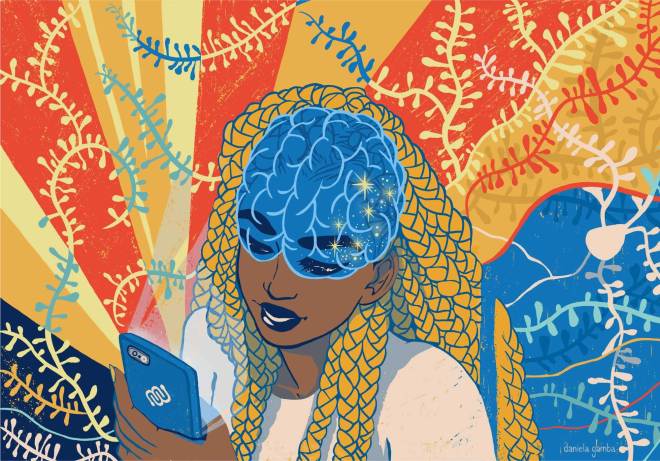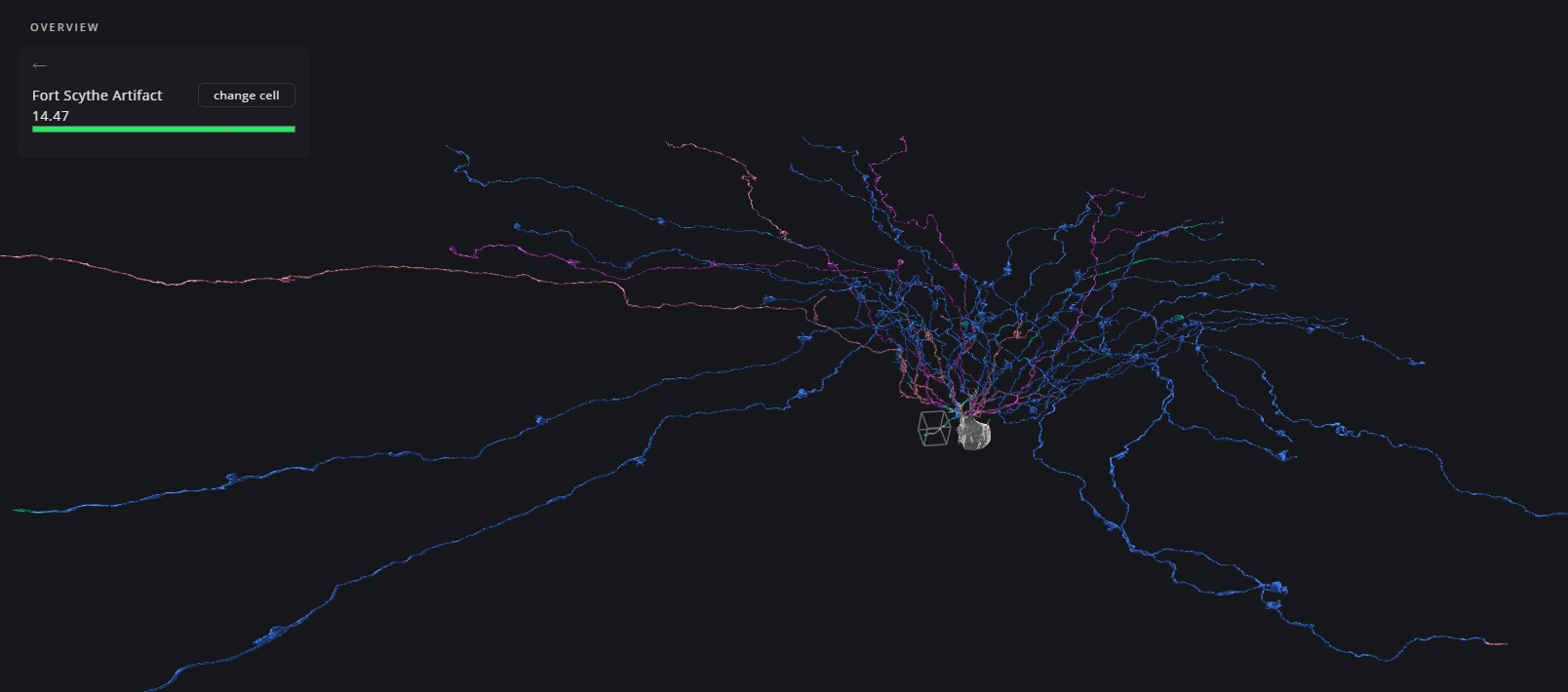EyeWire - continue to study the secrets of the brain

Mural sketch for the city of Cambridge, Massachusetts. Posted by Daniela Gamba.
The EyeWire game, about which I already wrote an article here , continues to produce new material. Scientists in the laboratory of Sebastian Seung do not rely only on the game and only on the efforts of science volunteers to advance research in the field of brain research, but it certainly has scientific value.
According to official statisticsgames for 5 years registered 265 thousand people from 186 countries (data based on player profiles and may be inaccurate). 10 million “cubes” with cell processes were analyzed, models for approximately 3,000 cells were completed. Is it a lot or a little? It took a team of scientists more than 10 years to fully describe 302 nematode neurons (C. elegans) and the connections between them, the work was completed in 1984. The article states that although computer help was used, most of the work on 8000 shots was done by scientists manually. Progress does not stand still and today we can “entrust” the process of reconstruction of neural networks to computer neural networks, but first these networks need to be taught. The problems of this process are described., for example, another team of scientists doing the reconstruction of Drosophila neurons. On the other hand, one cannot speak of a complete description of neural connections (connectomes) in more complex organisms without any radical improvement in the speed of modeling. In small animals and birds, the nervous system comprises from 10 to 500 million neurons, in large - more than a billion, in particular about 86 billion neurons in humans.
Despite the fact that attempts to fully describe the connectomes of entire animals are still far from successful, even individual discoveries greatly enrich the rapidly developing science. For example, publicationfinding new compounds in a well-studied part of Drosophila’s brain as a result of reconstruction of its connectome. Work is also underway on derivative research: for example, having a model of the nematode nervous system, build a general computer model of the worm itself, simulating its behavior. The OpenWorm project is engaged in this - an article on Habr, news on Habr.
But back to EyeWire. Along with how scientists work with raw data obtained from an electron microscope, volunteers at EyeWire actually create a set of verified data. The “side effect” of creating such a set of reference data is the discovery of new types and subtypes of cells that scientists have not previously encountered. Human decisions also help in cases where it is impossible to distinguish the course of the branches of a neuron on a cut due to their intersection with another neuron. A simple connection according to certain signs, such as brightness, does not make it possible to understand that we have before us the branching of the neuron under study or part of the branch of another ( examples on the game’s website). In addition to illustrations, from which it becomes clear why it is difficult even for a person to reconstruct cell processes, I preparedvideo with the game process. The video records the reconstruction of several “cubes” with cell processes, and at 1: 40-2: 20 one of the defects (non-contrast intersection) is visible and the process continues beyond it.
The data that EyeWire is currently working with is divided into 2 large parts: neurons from mouse retina and more complex cells from the brain of the zebrafish fish. First datasetit has a size of 16 sectors, each 50x50 microns, the number of cells is estimated in 2000. Work on the dataset started in January 2016, in December 2017 (the 5th anniversary of the game) the last cells from 9 sectors were studied, in May 2019 it was already mid 14 sectors. At the same time, we do not take glial cells to build - they are auxiliary and (as far as I know) do not form synapses with other neurons. In the laboratory there are those who help with the organization of the process (game makers) and those who work with already processed cells and their connections, considering them from the point of view of modern views on the functionality and connections of this part of the brain.
In a previous article, I mentioned Zoouniverse as an example of a platform where, with the help of amateurs, quite scientific tasks of various directions are solved. Eyewire has a number of differences from Zoouniverse scripts, for which it took to write your own engine and why the community in the game is not necessarily connected with other projects.
Simulation takes place in three dimensions, the neuron picture is completely three-dimensional.

The process begins with the gamemaker finding a previously unreconstructed cell nucleus in the dataset and removing the first processes from it. Then, the gamemaker gives a link to this “germ” and asks experienced players to evaluate the complexity of the cell (1 or 2). At some point, the cell is taken out to the public, from that moment on, any player in the game who has passed the training material of the appropriate level can work on it. In lighter cells of type 1, where beginners have access, the cube is considered completed if there are three reconstructions, and if at least one of the reconstruction segments abuts against the cube wall, the game looks for a neighboring section in the dataset and substitutes it for further play. In case of a conflict of opinion, the game will reckon with the majority. The majority opinion can be corrected by players with editing access (the opportunity is given by the administration with several months of experience and high accuracy parameters of previous reconstructions) and the administration itself (game makers). Also, players with access to edit place the label “completed” on the cube, while it drops out of the gameplay. As soon as the “completed” labels from two different players are placed on all the cubes, game makers take the cell for the final check. In the laboratory, they have a visualization of all reconstructed cells and the connections between them, which allows us to find shortcomings and problem areas. As soon as the “completed” labels from two different players are placed on all the cubes, game makers take the cell for the final check. In the laboratory, they have a visualization of all reconstructed cells and the connections between them, which allows us to find shortcomings and problem areas. As soon as the “completed” labels from two different players are placed on all the cubes, game makers take the cell for the final check. In the laboratory, they have a visualization of all reconstructed cells and the connections between them, which allows us to find shortcomings and problem areas.
Despite the relatively small number of active participants (100-200 people give about 90% of the contribution per month), it is already clear that on this dataset both the game and the study of the brain of small animals with its help will not end. For experienced players, a zebrafish brain dataset is available in parallel, and a team of game makers and developers is planning a new project called Neo, which will study axons (rather than dendrites, as it is now). I didn’t like the preview of the game that I saw (it felt like focusing on children of secondary school age), but I will look forward to what comes of it. Timing, as often happens, was postponed more than once.
